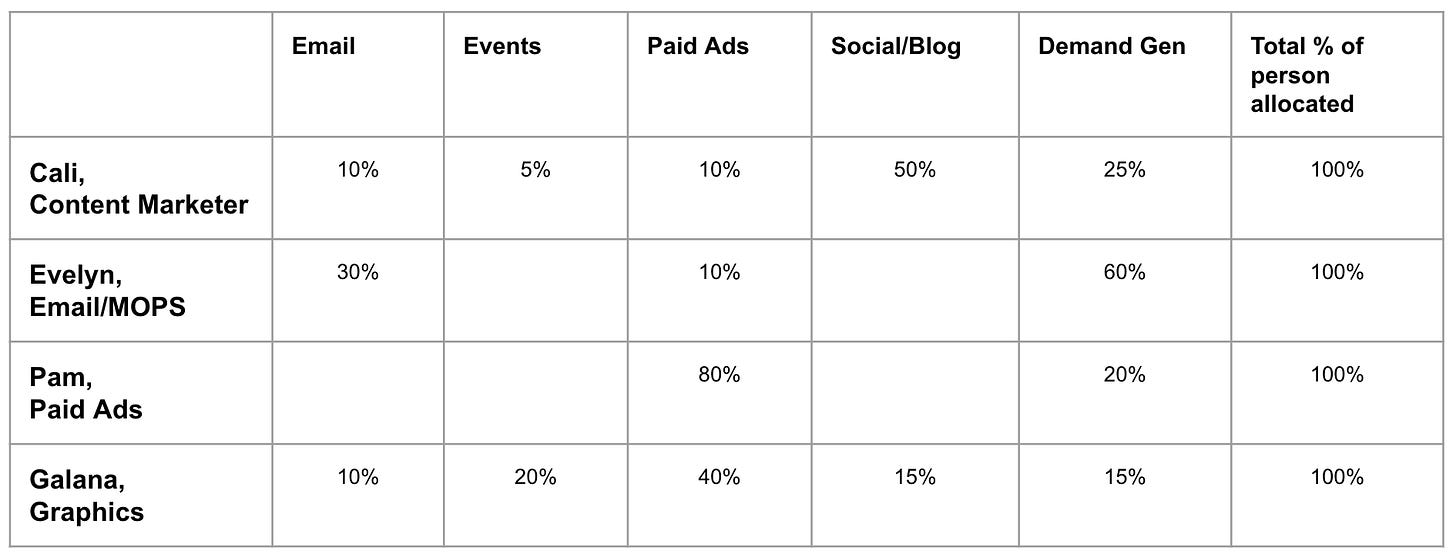Marketing Budgeting and Planning
It's the most wonderful time of the year, said no CMO or CRO ever
A good rule of thumb in marketing is to plan 6 months out, but for some reason when it comes to end of year, we’re stuck waiting on budgets to see how much we’ll get so we can plan. My advice: plan as if your budget will be flat and not increase.
What most don’t understand outside of marketing is that depending on the sales cycle and your outbound efforts (from sales or marketing), your company doesn’t realize the benefit of marketing’s labor until the next quarter or two out. The later your activities, the later you see the impact of them. That’s why I try to front load 70% of my activities in the beginning of the quarter and drip out the rest over the remaining quarter.
When budget planning I’ve often had to back into the number I was given by finance, listing each activity in my plan and estimating what each of those activities would yield. It’s a painful process but helps you understand if you have enough budget to pull it off and if you are focused on the right activities to hit your number.
Like this example, which Demand Gen usually fills out, listing all of the events and then mapping out the expected leads, MQLs, pipeline, and opportunities:
As CMO I was often asked to produce more complex charts using the above data plus mapping out program + headcount costs for each activity type/tactic. This was helpful to indicate whether we needed headcount or were understaffed.
And when you combined the ROI per channel with what people were being paid and their time allotment, you could see where efficiencies and inefficiencies are and make changes accordingly.
Then the next step was mapping out the results I’d get for each line of business so I could see how many MQLs I needed to get the number of opportunities that would move to closed won.
Like this, where in this case Stage 2 opportunities always have a $ amount associated with them (if you’re is Stage 3 or you have no rule, then use the stage that best fits):
True costs
Every company is different. If I could have it my way, I’d only track tech stack costs + program costs. To get a true cost of cost per MQL (CPMQL) I only look at program costs, however, the CFO/Finance is looking at all costs, tech stack + people + program costs and that’s the CPMQL number that gets showed to the board when you are not in the room.
This is why startups are so hard. You need people, tools, process and AI to get the brand awareness you need for the acquisition and growth you’re trying to attain. Unless there was a recent round of funding, the budgeting and planning process is like a gnat at a picnic as far as CMO or CRO activities go.
Summary
As CRO, where I owned both marketing and sales, I had to also do the sales hiring planning. How many reps was I going to need to attain the quarterly goals given to me by finance? The issue here is you need something like chart #1 or chart #3 above to determine if you’ll have enough pipeline to feed the sales team. This is where we wind up lopsided in many startups.
Many VP of Sales will want to add reps a quarter in advance as it usually takes time to ramp the rep before they are producing ARR. But adding one rep per quarter means you have to add more pipeline starting in the quarter that rep is expected to produce ARR. For Demand Gen, this just means more activities and usually not more budget.
So when I plan ahead of time, I like to plan as if the budget were flat, then add on from there. When sales comes forth with their headcount proposal, I look at the budget I planned and see where I fall short. Ideally, you’d work with sales together on this, but I’ve not been that lucky in the past. This is where you’ll be able to make the case for more budget, especially if the sales headcount goes up significantly.







This hits so close to home!
Back when I managed marketing for a sports accessories brand (that sales cycle planning was a wild ride), I learned the hard way about front-loading activities.
You know what's fascinating? While everyone was obsessing over Q4 plans, I found that launching major campaigns in Q1 actually gave us better results (plus way less competition for attention).
Running an e-commerce platform taught me that waiting for "perfect" budgets is like waiting for perfect weather - sometimes you just need to start with what you have :)
Here's a fun twist - I recently experimented with AI automation in marketing operations, and it actually helped us get more accurate pipeline predictions.
The real game-changer wasn't the tech though - it was finally connecting marketing activities to actual sales outcomes. (Those CFO meetings got way less stressful when we could show clear ROI D:)